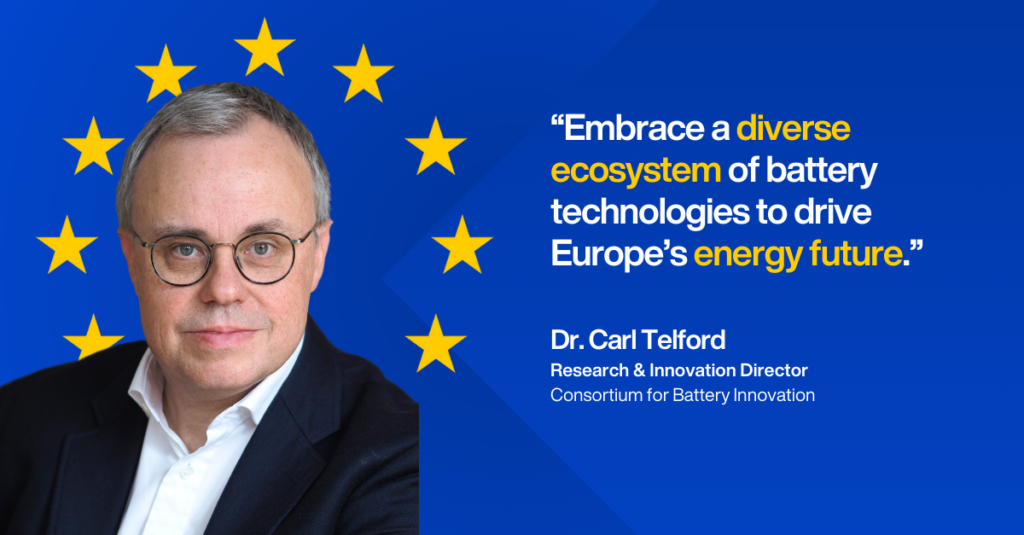Affordable energy storage for Europe
From a speech by Dr Carl Telford at the European Parliament in Brussels
As the Consortium for Battery Innovation’s name implies, my work places me in the middle of European energy storage activity. I work with large battery companies, universities, and put exciting project together. CBI’s core research aims at improving the capabilities of advanced lead batteries – but we are also technology agnostic and are extending our research to include other battery chemistries. Not just lithium, but sodium, zinc, redox flow, and perhaps technologies that are hitherto unknown.
The key thing is, we recognise the role of all these technologies in enabling energy security, decarbonisation, and affordable energy provision.
The European energy storage industry is already an impressive space. From Germany, to Portugal, Italy, Bulgaria and more – I have travelled and visited advanced lead battery manufacturing facilities across the continent. Combined, we have a pan-European multi-gigawatt production capability at our fingertips. Today. These batteries are used in a wide variety of mission-critical applications, not just car batteries but also renewable energy systems, backup power, peak shaving, nuclear power plant operation, and defence applications such as tanks or submarines. They are a critical to European security and a key piece in the jigsaw puzzle that is the Clean Industrial Deal and the Affordable Energy Action Plan.
I recently visited a European factory, and as part of a factory tour, I was shown a battery about the size of a large box. It was a metre high . A rather anonymous looking thing. But without this box, you could not operate a nuclear power plant safely. A big battery, with an even bigger responsibility.
In most of these factories, old batteries come in at one end, and new batteries come out the other end. The lead battery industry is a closed loop. This is not only a good thing from a circularity perspective, but also from cost and energy-security perspectives. These are batteries whose raw materials are all freely available in Europe, with zero reliance on expensive difficult-to-source materials.
A lot of the work I do relates to renewable energy and energy storage systems or ESS for short. The ESS market is growing rapidly. A recent report by KPMG noted that the European market for ESS will approach 200GWh-per-year by 2035, and lead batteries have the potential to supply an important chunk of this, around 10-15GWh-per-year. CBI recently visited the Isle of Eigg, off the Northwest coast of Scotland. This community relies on a microgrid with an advanced lead-battery storage system to provide affordable electricity. You see the same story across the world, from Africa to Antarctica. We make tough, cost-effective batteries for challenging environments.
Our industry also conducts cutting edge research, which doesn’t always fall under the spotlight. I’ve put together a microgrid project for Horizon Europe which features a battery that, when fully charged, becomes an electrolyser, producing hydrogen. You don’t run out of storage, you just transition to another energy vector. Electrons to gas. This technology – called a battery-electrolyser or battolyser – is a European invention, developed in the Netherlands and the UK.

Another project we co-founded is called Aftrak. It combines a small, low-cost electric tractor, a scalable solar microgrid, and a novel agricultural technique. The tractor enables African farmers to increase their yields, sell surplus crops, and lift themselves out of subsistence. It is electrical and economic empowerment. I have seen this project grow from an idea on a scrap of paper in a hotel in Malawi, to a government-funded project, to an international prize winner, to a startup company, in 3 years.
These exciting projects would not be possible without the brilliant University scientists, imaginative startups, and determined, practical and supportive lead-battery manufacturers we have at our disposal in Europe.
We must not take them for granted; there is much more we can do.
My message to decision-makers in Europe is this:
- Embrace an ecosystem of battery technologies – including advanced lead batteries – in Europe. Value what we have here and help companies us to invest, grow and thrive.
- Support Battery Energy Storage systems of all flavours, as part of an integrated and flexible energy grid. The foundation of affordable energy.
- Create the best possible conditions for battery makers based here to innovate, invest and grow through proportionate regulation, access to finance, and ongoing research funding.
Thank you.
